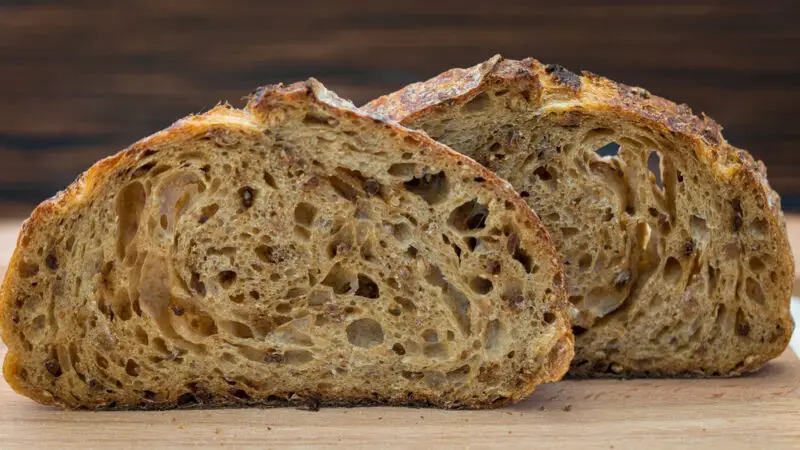Can You Add Baking Soda to Sourdough Bread?
Sourdough bread is a type of bread that has been around for centuries, dating back to ancient Egypt. This bread is made from a natural yeast called “sourdough starter,” which gives the bread its unique flavor. One of the main challenges when making sourdough bread is getting it to rise properly. Adding baking soda to sourdough dough may help in this regard and even lend some changes to the flavor profile.
What is Sourdough Bread?
Sourdough bread is a type of bread that is made using a natural yeast starter instead of commercial yeast. The starter is made by mixing flour and water together and allowing it to ferment for several days. During this time, wild yeast and bacteria will begin to grow in the mixture, causing it to rise and creating a distinctive tangy flavor.
The ingredients for sourdough bread are simple – flour, water, salt, and the sourdough starter. However, the fermentation time needed for sourdough tends to be longer compared to normal bread. This allows the natural yeast in the dough to do its magic properly and thus produces good results.
The Role of Baking Soda in Baking
Baking soda, also known as bicarbonate of soda, is a commonly used leavening agent in baking. It reacts with other ingredients such as acids or heat (sometimes both) which causes Carbon-di-oxide gas to be released. This gas bubbles up through the dough or batter causing it to expand/ rise.
Baking soda helps to neutralize the acidity level in the dough and can result in softer baked goods. However, one should note that adding too much baking soda can leave a bitter taste in baked goods.
Can You Add Baking Soda to Sourdough Bread?
The answer is yes, you can add baking soda to sourdough bread. However, there are pros and cons to adding baking soda to sourdough bread. One of the advantages of using baking soda is that it can help speed up the rise time of the bread dough. Also, it helps give a lighter texture to the bread crumb as compared to without adding baking soda.
However, the disadvantages could include creating a flavor imbalance or altering the tangy taste, which is typically associated with sourdough bread. Adding too much baking soda can also result in a distinct aftertaste and may leave your loaf cake-like instead of having a robust crust.
Factors to Consider
- Pickling Quality (pH level): Baking soda causes alkaline conditions that affect the bacteria population responsible for fermentation in sourdough making. Therefore, ensure that when adding baking soda, your dough pH level does not exceed 8. This could ruin fermentation and hence impact the flavor and texture.
- Fermentation Time: Sourdough requires longer fermentation times than traditional bread; thus, adding baking soda requires one to observe how long he should let his/her dough rise based on temperature changes that will occur during rising.
- Type of flour used: Some types of flour may have less acidity due to lower ph values. In this case, adding an acid like lactic acid or vinegar would be beneficial since these constituents would combine with baking soda hence leading to carbon dioxide release needed for proper fermentation.
Alternatives to Baking Soda for Sourdough Bread
People decide on using other leavening agents when they do not want their bread looking cake-like and also to maintain the traditional sourdough bread’s texture. The following are some alternatives to baking soda:
Yeast
The most commonly used leavening agent for traditional sourdough bread is yeast. Yeast consumes sugar and releases carbon dioxide, resulting in the dough rising. Yeast comes in commercial forms, or one can opt for natural yeast from making the sourdough starter.
Baking Powder or Cream of Tartar
Baking powder and cream of tartar were more commonly used before baking soda became popular in America. Unlike baking soda, which needs an acid to react, baking powder already has an acid powder combined into it, requiring no further additives. Cream of tartar can be used to provide additional acidity when needed but remember one should still observe the pH level provided previously.
Step-by-Step Guide for Adding Baking Soda to Sourdough Bread
If you have decided to use baking soda in your sourdough bread recipe, here is a step-by-step guide that can help you achieve the best results:
Step 1: Choose a recipe that includes baking soda or modify an existing recipe
Before you start, choose a recipe that already calls for adding baking soda to sourdough bread or modify your current recipe to incorporate it into the dough.
Step 2: Adjust the measurement of other ingredients accordingly
Since baking soda is alkaline, it neutralizes acidity levels within sourdough. Therefore, creating an imbalance with other ingredients can lead to terrible results when making sourdough bread.
Step 3: Incorporate the baking soda into the dough properly
Incorporate baking soda with other dry ingredients before adding it to the wet ingredients. Baking soda is a potent leavening agent, and using too much can lead to bitter and metallic aftertastes. Depending on how acidic your dough is, start by using 1/4 teaspoon for every cup of flour then gradually increase from there but carefully observe and track the changes.
Step 4: Monitor the rise and texture during fermentation
Watch the rise of your bread dough during fermentation as baking powder tends to rise quickly, so ensure you are always checking the dough often; otherwise, it will over-rise. This could lead to terrible results in both the flavor profile and texture of your bread.
Troubleshooting Problems When Adding Baking Soda to Sourdough Bread
Some common problems that may arise when adding baking soda to sourdough bread include poor fermentation, incorrect balance of ingredients altering the flavor profile, and affecting its general texture.
Here are some tips that can help avoid these problems:
- Ensure your pH levels are not too high or very low so that bacteria responsible for fermentation will colonize during rising cycles properly.
- Do not use excessive baking soda as this can also alter the flavor profile of your bread.
- If you notice poor fermentation, allow your dough to ferment for more extended periods.
- Incorporate other leavening agents: You could mix different leavening agents or sweeteners with different rich flavors (i.e., honey/molasses)
Baking Soda Safety Guidelines
Baking soda is generally safe when used as a leavening agent in food products. However, it should be noted that excessive consumption can lead to digestive issues such as gas, bloating, and stomach cramps. Also, keep baking soda out of reach of children as it can be harmful if ingested in large quantities.
FAQs about Adding Baking Soda to Sourdough Bread
1. Is it necessary addition to add baking soda when making sourdough bread?
No, it is not necessary to add baking soda when making sourdough bread; one could use other leavening agents instead depending on preference.
2. What are the alternatives to baking soda for sourdough bread making?
The most commonly used alternatives are: Yeast, Baking powder or Cream of Tartar, or natural means such as letting dough ferment naturally over time.
3. Can you replace baking soda with other leavening agents such as yeast?
Yes, you can use yeast and still achieve same good results when making sourdough bread.
Conclusion
Sourdough bread is a favorite for many people, and adding baking soda to the recipe is just one way to customize the taste and texture of your loaf. One should keep in mind that this should be done carefully so as not to create an imbalance that could ruin the entire loaf. The best thing would be to experiment with different combinations till you find what works best for your preferences without much alteration of the traditional flavor profile of sourdough bread!
#### Is it possible to add baking soda to sourdough bread?
Yes, it is possible to add baking soda to sourdough bread. However, it will affect the taste and texture of your bread. If you are looking for a more traditional sourdough flavor and texture, we recommend avoiding the addition of baking soda.
#### How does adding baking soda affect sourdough bread?
Adding baking soda to sourdough bread will make it less chewy and dense, giving it a lighter and cakier texture. It will also neutralize some of the acidity in the dough, resulting in a less tangy flavor. Keep in mind that the use of baking soda in sourdough bread is not traditional and may not produce the desired results.
#### Can I substitute baking soda for yeast in sourdough bread?
No, you cannot substitute baking soda for yeast in sourdough bread. Yeast and sourdough starter are both leavening agents but work differently. Yeast ferments quickly, while sourdough starter requires more time and a careful process to develop. Baking soda also reacts differently than yeast and does not provide the same rise or complex flavor profile.
#### What are some alternatives to adding baking soda to sourdough bread?
Instead of adding baking soda, you can try adding ingredients that enhance the flavor and texture of your sourdough bread. Some common additions include wheat bran, whole wheat flour, rye flour or seeds such as sesame or poppy seeds. You can also use different types of flour, like spelt or einkorn, which can add unique flavors and textures to your bread recipe.






